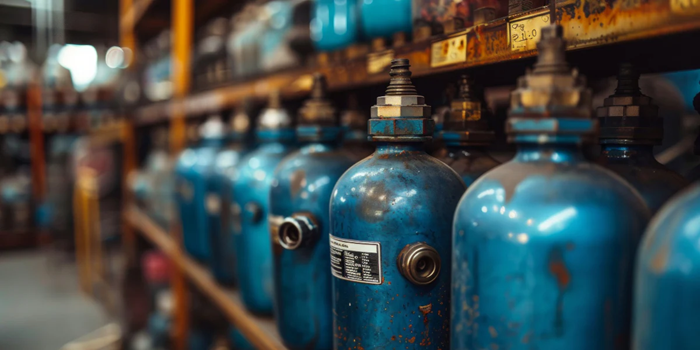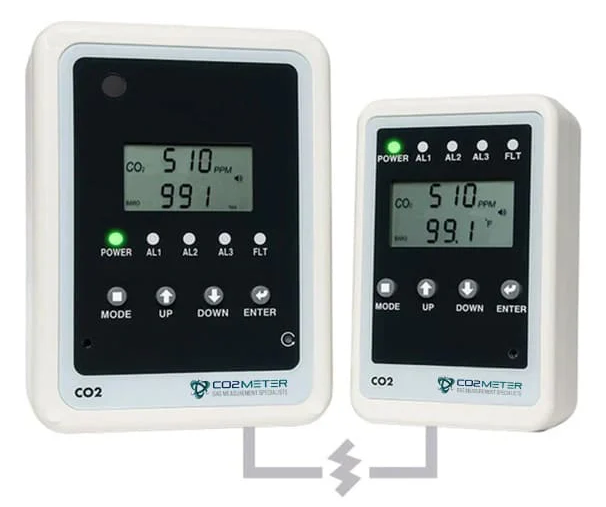The Compressed Gas Association (CGA) recently released a vital new safety standard: CGA GC6.14, Safety Requirements for the Storage and Handling of Carbon Dioxide in Beverage Applications.

Image Credit: CO2Meter, Inc.
This standard represents a major milestone in enhancing safety practices for establishments and facilities that utilize or store carbon dioxide (CO2), most notably in environments that work with beverages such as breweries, bars, restaurants, and quick-service locations.
CO2Meter is committed to supporting businesses in remaining compliant and safe. This article examines the impact of CGA GC6.14 and its relevance to the industry while also offering useful guidance on implementing it effectively in the workplace.
Understanding Compressed Gases
The guidance defines compressed gas as "a mixture of gases having, in a container, an absolute pressure exceeding 40 psi at 70 °F (21.1 °C); or a gas or mixture of gases having, in a container, an absolute pressure exceeding 104 psi at 130 °F (54.4 °C)."
Working in and around compressed gases can pose a range of risks, including:
- Oxygen displacement
- Fire and explosions
- Physical hazards
- Toxic gas exposure
Various standards have been established to lower the risk of staff injury and improve awareness of the hazards linked to compressed gases, their equipment, handling, and control.
Understanding CGA GC6.14
The Compressed Gas Association’s GC6.14 guidance outlines minimum gas safety requirements for the handling, storage, and use of CO2 in beverage dispensing applications.
Specific requirements are included for the installation of CO2 systems, signage, ventilation, training, and gas detection safety monitoring requirements in enclosed areas.
GC6.14 aims to mitigate the health and safety risks linked to CO2 exposure. This new guidance reflects growing concern throughout the industry around the risks associated with CO2, particularly when carbon dioxide is used in confined or poorly ventilated spaces where the gas can build up undetected.
The Importance of CGA GC6.14
There has been a notable increase in CO2-related incidents in the food and beverage industry over the past decade, including both fatalities and near-misses stemming from leaks in beverage gas systems.
CGA GC6.14 aims to address these risks directly, introducing a framework that prioritizes:
- Gas detection safety systems
- Safe cylinder storage and handling
- Ventilation requirements
- Employee awareness, training, and advocacy
These measures go beyond best practices and are now regarded as imperative components of compliance and life safety.
Complying with CGA GC6.14
CGA GC6.14 applies to any facility, establishment, or business that uses CO2 for beverage dispensing, including:
- Bars and nightclubs
- Restaurants and cafés
- Breweries and distilleries
- Quick-service restaurants (QSRs)
- Food courts and franchises
- Stadiums and event venues
GC6.14 stipulates that owners, gas suppliers, facility managers, and installers are all responsible for ensuring that systems are installed and maintained in line with the guidance.
Gas Distributors’ Role in Complying with GC6.14
CGA GC6.14: Standard for Safe Practices for the Production, Storage, Distribution, and Use of Carbon Dioxide states that both gas distributors and certified installers have a critical role to play in ensuring end-user compliance.
This newly established guidance emphasizes correct installation, regular maintenance, and comprehensive documentation of CO2 systems, particularly where CO2 is utilized in enclosed or confined spaces.
Distributors and installers are responsible for supplying safe CO2 and must ensure that all systems and components adhere to the requirements specified in the current CGA GC6.14 standard.
Distributors are required to verify that each step follows best safety practices, ranging from the initial delivery of cylinder or bulk CO2 to the final connection of piping systems and alarms.
Gas detection safety systems must be installed where necessary, signage should be clearly visible, and customers are required to be informed of any potential hazards.
Installers must ensure that pressure regulators, tubing, manifolds, and gas detection safety systems are installed according to code and that they are accountable through appropriate recordkeeping and client education.
Installers are also required to document system specifications and alarm calibrations carefully, offer training to facility managers and staff, and for ensuring that appropriate signage is in place.
Hands-on training and education ensure that the installers’ customers understand their specific responsibilities under CGA GC6.14, including the maintenance of gas monitors, the completion of regular inspections, and ensuring appropriate responses to alarms.
Failure to meet these responsibilities can result in unsafe working environments, non-compliance, and liability issues for the distributor and the customer.
Gas distributors and installers function as frontline compliance partners for businesses working with CO2. Their capacity to correctly interpret and effectively implement CGA GC6.14 safeguards people and property as well as improving trust throughout the supply chain.
By acting as advisors, gas distributors and installers improve overall industry standards while reinforcing a vital safety culture within breweries, restaurants, cultivation facilities, hospitals, and other workplaces.
Safety Requirements Outlined in CGA GC6.14
CGA GC6.14 is divided into several key sections, each outlining safety practices and responsibilities for facilities using or storing CO2 in beverage applications.
A brief overview of the most relevant sections for organizations focused on gas safety monitoring and CO2 hazard mitigation strategies is provided below.
Section 1: Scope and Purpose
This section defines the standard’s goals around the protection of staff and members of the public, establishing a series of minimum safety requirements around the storage and handling of CO2 in beverage applications.
Section 2: Definitions
This section defines and clarifies key terms, including “permissible exposure limits,” “confined space,” and “gas detection systems,” ensuring that interpretation of these terms is consistent throughout the standard.
Section 3: General Requirements
This section outlines key expectations around equipment use, facility layout, and hazard communication. It also states that all CO2 gas safety systems should be thoroughly assessed for potential risks and carefully monitored.
Section 4: System Design and Installation
This section focuses on engineering controls such as gas safety system placement, ventilation design, and the correct installation of CO2 cylinders and piping. It also requires that CO2 gas sensors are installed in low-lying areas where there is a risk of gas collecting.
Section 5: Gas Detection and Safety Alarm Requirements
This section is one of the most critical in terms of compliance, specifying that fixed gas monitors should be fitted in areas where there is a risk of CO2 accumulation.
It is also essential that monitors activate visible and audible alarms at both the TWA (5000 ppm) and STEL (30000 ppm) thresholds. Alarms must also feature indicators that are visible to workers.
Section 6: Inspection, Testing, and Maintenance
This section stipulates that periodic system checks take place, including CO2 gas safety system calibration and alarm testing. Documentation of inspections must be maintained, and facilities are required to demonstrate that systems remain in working order at all times.
Section 7: Employee Training and Safety Protocols
The section outlines the importance of documented training programs focused on CO2 hazard recognition, proper use of safety equipment, alarm response, and robust evacuation plans.
Section 8: Emergency Procedures
This section requires that facilities develop formal response protocols to be implemented in the event of a CO2 leak or alarm condition. It is important that emergency plans include ventilation responses, evacuation routes, and coordination with first responders.
Aligning a facility’s safety practices with these key sections and implementing robust CO2 measurement technologies such as CO2Meter’s RAD-0102-6 system ensures a robust, compliant, proactive safety culture around CO2 gas handling.
Meeting CGA GC6.14 with CO2 Gas Safety Monitoring
An investment in a robust CO2 gas safety monitoring system is essential for any business aiming to be fully compliant with CGA GC6.14.
CO2Meter’s RAD-0102-6 Remote CO2 Storage Safety 3 Alarm is one of the most widely implemented solutions on the market. This fixed gas detection safety monitor has been specifically developed to monitor CO2 levels in enclosed storage areas, issuing real-time alerts should a leak be detected.

RAD-0102-6. Image Credit: CO2Meter, Inc.
The RAD-0102-6 features built-in visual and audible alarms and can be seamlessly integrated into the existing infrastructure of any food, beverage, or agriculture facility.
CO2Meter has expanded its capabilities for larger facilities with two powerful new accessories: the RAD-PMU (Power Monitor Unit) and the RAD-CDU (Central Display Unit).
The RAD-PMU enables flexible power loss management, while the RAD-CDU allows a range of gas systems across multiple facilities to be monitored at a central location.
Implementing this system ensures compliance with CGA GC6.14, OSHA, local fire codes, and the International Fire Code (IFC). It also helps mitigate the risks associated with CO2 accumulation by providing immediate, actionable alerts to protect customers, staff, and property.
Key Benefits of the RAD-0102-6 System:
- Three alarm levels built in, accommodating TWA, STEL, and high-level alerts
- Straightforward integration with emergency shut-off or ventilation systems
- Bright visual LED indicators coupled with loud 80 dB audible alarms
- Expandable options for relay control and remote display units
- Plug-and-play installation along with pre-calibrated sensors
Implementing an established solution such as the RAD-0102-6 with the RAD-PMU and RAD-CDU accessories allows facilities to remain compliant, maintain a safer working environment, and protect their people and infrastructure.
Steps to Implement CGA GC6.14 in the Workplace
It can be challenging to properly comply with CGA GC6.14, but the right information and guidelines can make its implementation a straightforward process.
Implementing CGA GC6.14 in a facility begins with a few simple steps.
1. Assess Risk
- Identify any enclosed area where CO2 is used or stored
- Install Compliant Monitoring Equipment
- Leverage CO2Meter’s central displays and fixed detectors
2. Improve Ventilation
- Meet airflow requirements by working with HVAC professionals
3. Train and Educate Employees/Staff
- Complete training sessions on CO2 hazards and alarm response every year
4. Maintain Adequate Documentation
- Maintain appropriate logs of sensor calibration, inspections, and staff training
Summary
CGA GC6.14 is set to revolutionize CO2 safety practices and overall gas safety. Incidents due to undetected CO2 leaks or overexposure continue to occur, with standards like CGA GC6.14 representing a proactive approach to life safety.
Facility managers, installers, or gas suppliers must understand and apply this new standard.
CO2Meter’s team is on hand to offer expert advice, product recommendations, and safety consultations as required.
CO2Meter has already partnered with gas distributors, beverage gas distributors, and restaurant chains across North America to implement gas safety systems designed to meet compliance standards like CGA GC6.14 and ultimately protect lives.
Acknowledgments
Produced from materials originally authored by CO2Meter.

This information has been sourced, reviewed and adapted from materials provided by CO2Meter, Inc.
For more information on this source, please visit CO2Meter, Inc.